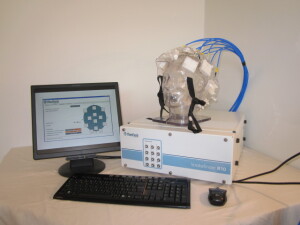El casco de la microonda puede substituir CT para los pacientes del movimiento
por
Lauren Dubinsky, Senior Reporter | June 19, 2014

Courtesy of Medfield Diagnostics AB
A new device called Strokefinder may be be used on the move to determine if a patient has had a stroke.
It utilizes microwaves to help make the determination. The helmet-like antenna-lined device is placed on the patient's head and then the antennas transmit weak microwave signals into the brain and then capture information reflected back in signals. The signals that are received produce a complex pattern that is interpreted with advanced algorithms. With that information, it can diagnose a patient with either bleeding or a clot.
It has proven its usefulness in an initial patient study, which was published in the newest issue of the Engineering in Medicine & Biology Society's journal.
Researchers from Chalmers University of Technology, Sahlgrenska Academy and Sahlgrenska University Hospital in Sweden joined together to test Strokefinder on 45 patients in hospitals. The results showed that it can differentiate patients with bleeding strokes and those with clot-induced strokes.
Since there is no way to determine what type of stroke a patient has suffered based on the patient's external symptoms, they have to wait until they get a CT scan at the hospital before they can be treated.
Most patients have blood clots and can be treated successfully with clot-dissolving medicine, however, it has to be administered four hours before the start of the stroke. So only a small percentage of patients are diagnosed in time to receive the treatment.
On the other hand, patients who have strokes caused by bleeding cannot take the clot-dissolving medication because it could be lethal.
This fall, the researchers will test a mobile version on patients in ambulances. But before the device can be used routinely in ambulances, it needs to undergo larger comparative studies with CT.
"Potentially, in the future, when we confirm the results in the bigger clinical trial, we can start considering giving thrombolytic treatment to stroke patients already in the ambulance," Mikael Persson, professor of biomedical engineering at Chalmers University of Technology, told DOTmed News.
Strokefinder was created by Medfield Diagnostics AB - a Swedish company founded by Persson and his partner, Andreas Fhager.
Another thing the researchers are looking to do is have it so Strokefinder can transmit information from the ambulance to the hospital before the patient arrives. "That's the plan - that's the whole idea with the system," said Persson.
Dag Jungenfelt, CEO of Medfield Diagnostics, said that it's not just about the communication — they're looking to integrate Strokefinder with a more generic decision support system. But for now, the researchers are more focused on proving that the device can detect stroke patients and later they will conduct follow-up studies to prove that it can communicate with the hospital, said Persson.
They expect it to receive CE approval in Sweden later this year and they're already thinking about bringing it to the U.S. "We have just started to understand the different options when it comes from a regulatory perspective and that, of course, is a key issue for how and when to enter the U.S. market," said Jungenfelt.
Medfield Diagnostics is currently having discussions with a partner in the U.S. on the regulatory side to figure out the best way to go about bringing it to the market.
|
|
|
You Must Be Logged In To Post A Comment
|
